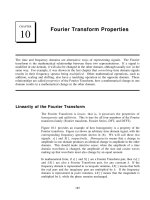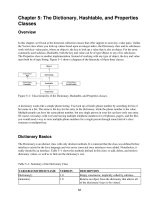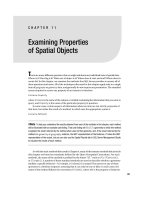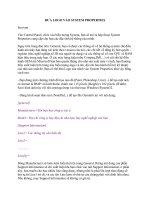Mineral properties
Bạn đang xem bản rút gọn của tài liệu. Xem và tải ngay bản đầy đủ của tài liệu tại đây (2.75 MB, 30 trang )
MINERAL PROPERTIES
Prepared by Dr. F. Clark,
Department of Earth and Atmospheric
Sciences, University of Alberta
Sept. 05
CLEAVAGE
A mineral has cleavage if it has one or more directions or
planes of weakness within the crystal structure along
which it will break when stressed. Because of the
regular, ordered arrangement of atoms that crystals
have, this means that the same cleavage will repeat
many times within the same crystal. Because a mineral
is defined in part by its crystal structure, cleavage is a
consistent and reliable property for identification. As
well, when a mineral has more than one cleavage, those
cleavages will always intersect at the same angles.
Breakage of a crystal unrelated to a cleavage is called
fracture.
Muscovite
This sheet
silicate has a
single perfect
cleavage,
accounting for
its flaky nature.
The yellow stars are on parallel cleavage faces that all represent the
same cleavage direction; the red arrows point to places where that
same cleavage could be developed; the blue arrows point to cleavage
flakes that have fallen off the specimen and reflect light.
Muscovite
The cleavage flake balanced on the main specimen can itself be cleaved
on progressively finer and finer scales (see red arrows). Nevertheless, it
is a single cleavage because it represents a single direction in the crystal
(see all five surfaces highlighted by yellow stars).
Halite
This mineral
exhibits three
cleavages that
are mutually
perpendicular.
This is called
cubic cleavage,
and produces
rectangular
specimens.
Faces or portions of faces following the three cleavage directions
corresponding to the stars on the right-hand specimen are highlighted
by arrows; note that cleavages exhibit steps corresponding to one of
the other cleavage directions.
Galena
This metallic,
lead-bearing
sulphide
exhibits cubic
cleavage (three
that meet at 90
degrees) just
as was seen
for halite.
The discontinuous nature of cleavage is particularly well displayed by
these specimens; note the large number of short steps and disruptions
to the cleavage faces, such that they are recognized as representing
the same cleavage only by virtue of reflecting light the same.
Calcite
Like halite and
galena, this
exhibits three
cleavages, but
they do not
meet at 90
degrees; this is
called rhombic
cleavage.
The three cleavage directions are marked with their own distinctively
coloured stars; notice that many faces have faint lines or traces on
them, marked by appropriately coloured arrows, where the
corresponding cleavage would develop if the specimens were struck.
Potassium
Feldspar
This mineral
has two
cleavages that
meet at 90
degrees, giving
squared edges
to the
specimen.
Highlighted by red arrows, one cleavage is expressed as several faces
that are catching the light at the same time; the green arrows highlight
the second cleavage (note that a small ridge is produced on the first
cleavage); faces marked by blue stars show irregular fracture.
Potassium Feldspar
There are two sets of planar cleavage faces developed on this crystal,
one highlighted in green arrows, the other with red arrows; they meet
at right angles. The face highlighted by a blue star exhibits irregular
fracture; the steps or discontinuities in the cleavage planes (blue
arrows) exhibit the same irregular fracture.
Quartz
This is a very
common
mineral that
has no
cleavages, but
exhibits
distinctive
conchoidal
fracture.
Blue arrows point to the characteristically curved ridges that develop
with this type of fracture; quartz typically grows as a hexagonal prism,
with triangular faces at the end of the prism (see specimen on right);
crystal faces should not be confused with cleavage or fracture.
Quartz
These three
specimens,
consisting of
several crystals
each, lack any
trace of planar
surfaces, either
crystal faces or
cleavages.
Although quartz ideally and characteristically grows as long, six-sided
prismatic crystals, it commonly occurs as irregular aggregates that fill
fractures in rocks to produce bright white vein fillings that show up
against the darker background of the host rock.
LUSTRE
Lustre is a qualitative description of the appearance of
reflected light from the specimen. It can be somewhat
subjective, and may also depend on the quality of the
specimen and the crystal size. The fundamental
subdivision is into those minerals whose lustre is
metallic, having the appearance of polished metal, and
those that are non-metallic, which of course do not.
There is a host of different lustres within the nonmetallic category.
Metallic Lustre
In the left photo, all three specimens are of the mineral pyrite, an iron
sulphide commonly known as Fool’s Gold. In the right photo, the left
specimen is pyrrhotite, also an iron sulphide, the center specimen
includes bornite, a copper-plus-iron sulphide, and the right specimen is
pyrite.
Galena +
Dolomite
The contrast
between
metallic and
non-metallic
lustre is
exhibited in
this specimen
from Pine
Point.
From this lead-zinc deposit near Great Slave Lake, metallic galena,
highlighted by red arrows, has been deposited in cavities within the
brown, non-metallic dolomite host rock. The two left arrows point to
the same large mass of galena; the right arrows to smaller masses.
Halite +
Galena
Both minerals
exhibit cubic
cleavage, as
highlighted by
the three sets
of arrows.
Placing non-metallic halite (left) next to metallic galena (right) simply
highlights the fact that minerals may share one or more properties with
others. It is the combination of at least a few properties that allows us
to uniquely identify minerals.
COLOUR
Colour is an obvious property, but one which is often
unreliable. Because of the variation in chemistry that is
possible for many minerals, plus the inclusion of trace
elements in the crystal structure which have a
characteristic interaction with light and cause distinctive
colours, for many minerals the colour is highly variable.
When the mineral is reduced to powdered form, which is
done by dragging the specimen across an unglazed
porcelain streak plate, this variability disappears, and we
get a consistent result which is reliable. We note that
certain minerals do have a consistent and characteristic
colour.
Quartz or
Silica
All specimens
are composed
of silica (SiO2),
either as
quartz, or as
other materials
with a different
crystal form.
For many minerals, colour is not a consistent and reliable feature, and
other properties must be used to identify them. Observe the several
different colours the same mineral may have, usually controlled by
trace elements in the crystal structure.
Colour Variations in Silica
On the left, we see various examples of Tiger’s Eye, an attractive stone
produced by the formation of silica mimicking the structure of a fibrous,
so-called asbestos mineral. On the right, the distinctive purple variety of
quartz called amethyst is seen; the colour results from the presence of
iron in a particular state.
Hematite
This iron oxide
mineral
exhibits a
number of
different
colours, and
even degrees
of metallic
lustre.
The upper right specimen is distinctly red-brown, and rather dull; the
upper left specimen a somewhat dull gun-metal grey colour, and the
lower specimen is quite shiny and also a gun-metal colour. What
property unites these specimens?
Hematite
A variable
mineral is
consistent in
one regard.
Note that the streak of all three specimens is red-brown, as seen on
the unglazed porcelain streak plates next to each one. Powdering the
specimen on such a plate (the hardness must be less than 7 for this to
work) eliminates the variation exhibited by the larger crystal sizes.
SPECIFIC GRAVITY
Specific gravity is the ratio of the density of a material to
the density of water at a specified temperature, and
therefore has no units or dimension. It can be
determined accurately using various techniques, and
resolution between minerals is possible to very small
differences. In practice, in hand specimen it is not
possible to resolve most minerals, whose specific gravity
lies in the range of 2.65 to 2.85 or so, but a few
minerals are unusually “hefty” (have a very high specific
gravity), and this will be readily detected in specimens
which are unusually heavy for their size.
Specific Gravity, (or “heft”, if you will)
On the left, its three cleavages highlighted by arrows of different
colours, is galena, PbS, the ore mineral for lead. On the right is the
mineral barite, BaSO4, which is ground up as an additive to drilling fluid
or mud, to give the mud sufficient weight to control high pressure
formation fluids when drilling exploration wells.
CRYSTAL HABIT
Crystal habit is the shape that crystals of a particular
mineral will exhibit when grown under ideal or
favourable conditions. Normally, simultaneous growth of
other crystals of the same or a different mineral will lead
to mutual interference and the development of what are
called compromise boundaries. As the term “habit”
suggests, this is not an invariant property, and one
notes that some minerals may exhibit different habits
depending on the conditions and circumstances of
growth.
Crystal
Habit,
Quartz.
This broken
crystal
demonstrates
part of the
typical habit of
this mineral.
Under ideal conditions, a quartz crystal grows as a six-sided or
hexagonal prism, and terminates with a set of faces, seen here, that
form a hexagonal pyramid.
Crystal Habit, Calcite
The sample on the left exhibits two habits for calcite, one as large,
almost clear crystals, the other as very fine, virtually opaque crystals
comprising the spaghetti-like masses. On the right, we see a specimen
which exhibits another habit for calcite, as scalenohedral crystals (see
reflective crystal in center of image in particular).









